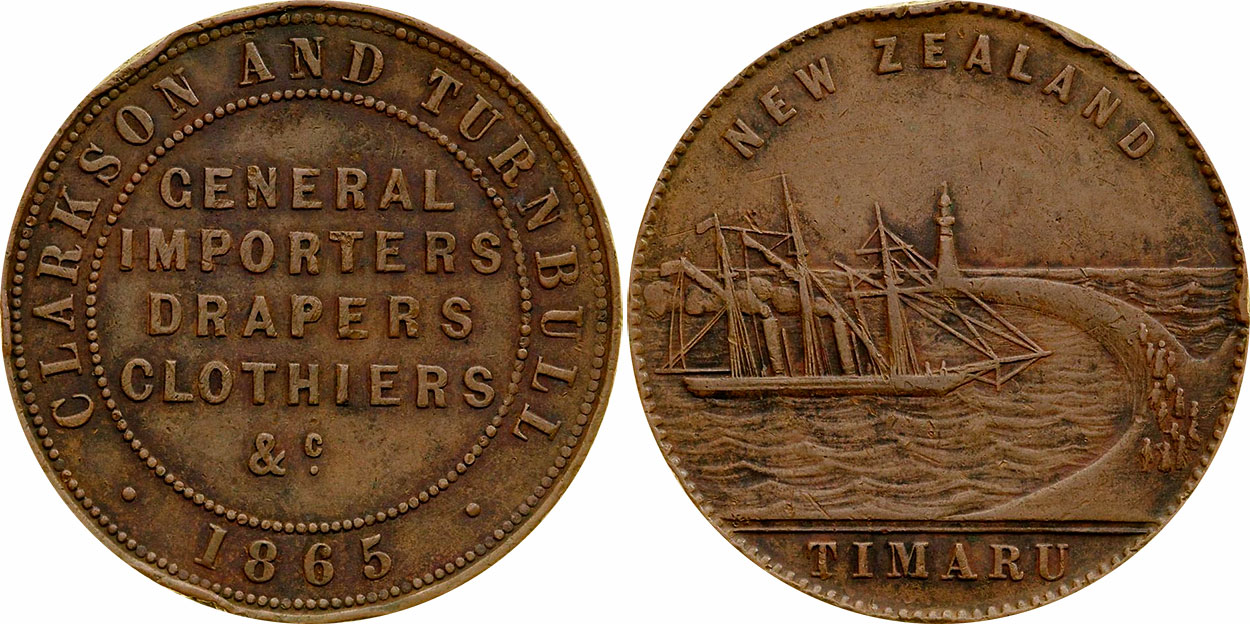Clarkson & Turnbull, Drapers, Timaru
By Museums Victoria | Thursday, 22 October 2020
The firm of Clarkson and Turnbull was founded in 1863 at Timaru, a port to the south of Christchurch. The Principals were David Clarkson and Richard Turnbull. David Clarkson had previously been associated with two Christchurch businesses that issued trade tokens. His brother, Samuel Clarkson, issued tokens in 1857, advertising his business as an importer of building materials. The business David and his wife Elizabeth Clarkson had run in Christchurch before moving to Timaru, a drapery business known as Dunstable House, was bought by William Pratt in 1864. Pratt issued trade tokens promoting his store in the period between 1864 and 1872.
The other partner, Richard Turnbull, was a farmer for eleven years before he entered into partnership with Clarkson. Richard Turnbull was born at Oxford, England in 1826, and arrived in New Zealand by the Fatima in 1851. He was farming at Riccarton for eleven years prior to his engagement in partnership in a general store at Timaru.
Timaru was only declared a Port of Entry in 1861, so it was still quite a young settlement when Clarkson and Turnbull opened their store. Their premises were of particular note in the township, a two-storey building at the corner of George Street and the South Road, whose cost would be about 2,500 [pounds]; plate glass for the windows was being imported from England at a cost of about 150 [pounds].
The business was the first to export flour from Timaru which since then has been continuous.
The partnership was disrupted on 9 December 1868 by a fire that consumed their premises, among a total of 30 buildings destroyed. The Timaru Herald recorded that:
...Even before the Bank of New Zealand had taken fire, the fine building of Clarkson & Turnbull, at the opposite corner, had been ignited by the flying fire. Then it was known that no power on earth could save the entire block...Adjoining the Post Office was the boot and shoe department of Clarkson & Turnbull, containing very heavy stock, and the flames leapt into this shop in a second of time. They then spread to other parts of the building with equal rapidity until the whole of the corner premises were enveloped and it was impossible longer to carry out things with safety. From all their departments in the corner shop, a two-storey building, and by far the finest in Timaru, we believe that only a little more than a thousand pounds worth of stock was saved. Some of the drapery was turned into the street, but the smoke from the block of buildings to the north, and the intense heat of the flames, were such as to drive back the most daring. The loss of Clarkson and Turnbull must be most serious as they had an enormous stock and were only partially insured.
Next to Dr Butler's was the ironmongery store of Clarkson & Turnbull, from which goods were being pitched into the street, but this lasted for only a moment, as the flames drove men back, and most of the goods thrown out of the shop were burnt in the middle of the road, or on the opposite side of the street. We believe the stock was only insured to the extent of...300 or...400 [pounds].'
After their premises were destroyed Clarkson & Turnbull dissolved their partnership. David Clarkson returned to Christchurch and Robert Turnbull remained in Timaru, carrying on their business in his own name. He was prominent in public life, being a member of first Borough Council in 1870, a member of the Provincial Council from 1872 until its abolition, a Member of Parliament from 1877 to 1890 and a member of the Timaru Harbour Board for six years. He died on 17th July 1890.
Oxford Buildings now occupy the site of Clarkson and Turnbull's first premises and these are the third building to be erected by the Turnbull family on this corner.
Clarkson and Turnbull issued their three varieties of penny tokens in 1865. The tokens were struck for them by an unknown British mint, according to the Museum Victoria Catalogue. The reverse of the token shows a view of a ship in harbour, behind a breakwater, underneath the title 'Timaru.' The harbour at Timaru was unsafe for vessels in high winds until the construction of a breakwater, a project that did not begin until 1879.




